Assistive Robotics [2017–]
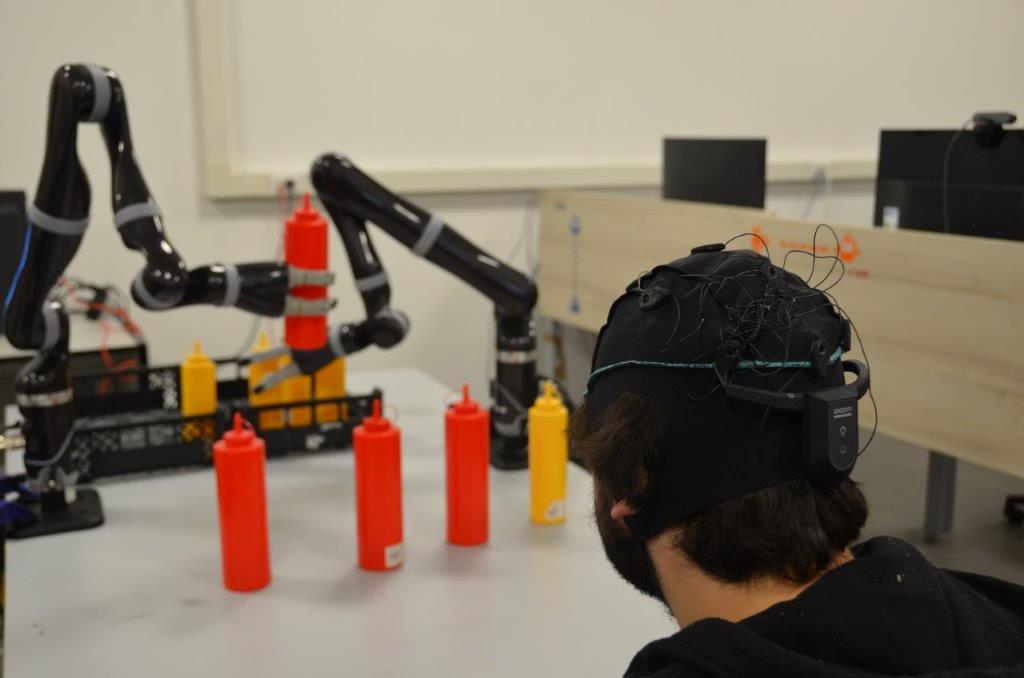
People affected by severe motor impairments might find difficult or impossible to perform daily life activities, such as getting dressed or fed, and, thus, require a constant presence of caregivers for assistance. In this context, robotic systems can certainly help such people in improving their life quality by providing some sort of autonomy in executing some activities and by reducing the needs of a constant presence of a caregiver. Indeed, in the recent years, the research community is devoting a great effort towards the development of suitable robotic solutions to assist people with physical disabilities, also thanks to factors such as the availability of proper devices with lower prices and higher performance and robustness. From a robotic technology perspective, the specific assistive scenario can be characterized on the basis of both the robotic system used to support the impaired person, and the Human-Machine Interface (HMI) adopted to allow the user to generate commands for the system. In particular, the HMI can rely on different types of signals, such as Electroocolugraphic (EOG), Electroencephalographic (EEG) and Electromyographic (EMG) signals, and diversified HMIs have been developed in the latest years trying to find suitable solutions for specific applications and impairments. Among the possible EEG devices, non invasive Brain Computer Interfaces (BCIs) are composed of headset with a series of electrodes to place on the scalp of the user to measures the EEG signals. These signals are then processed according to the considered brain activity patterns, i.e., motor imagery or Event Related Potentials (ERPs).
Mobile Multirobot Systems [2002–]
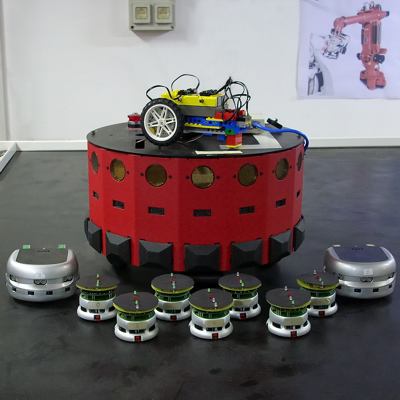
The field of cooperation and coordination of multi-robot systems has been object of considerable research efforts in the last years. The basic idea is that multi-robot systems can perform tasks more efficiently than a single robot or can accomplish tasks not executable by a single one. Moreover, multi-robot systems have advantages like increasing tolerance to possible vehicle fault, providing flexibility to the task execution or taking advantage of distributed sensing and actuation. Such systems can be used in many applications like, e.g., exploration of an unknown environment, navigation and formation control, demining, object transportation, up to playing team games (e.g., soccer). In this framework, we have developed a behavior-based approach, namely the Null-Space-based Behavioral approach (NSB), aimed at guiding single and multiple mobile robots to achieve different missions. The NSB approach, using a hierarchy based logic to combine multiple conflicting tasks, is able to fulfill or partially fulfill the elementary tasks composing the overall mission according to their positions in the hierarchy. The NSB has been extensively studied, simulated and experimentally tested while performing several missions with different kind of vehicles (i.e. mobile robots, underwater robots and surface vessels). E.g., the NSB has been used to perform formation control, entrapping/escorting a moving target, keeping a Mobile Ad-hoc NETwork, flocking with a platoon of autonomous grounded vehicles made up of 7 Khepera II mobile robots (manufactured by K-Team).
Cooperative Autonomous Surface Vessels [2005–]
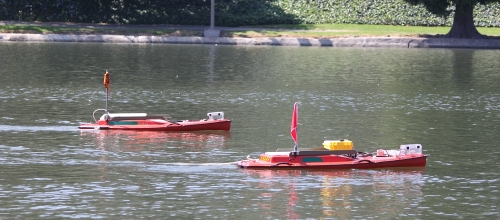
The control techniques developed for grounded mobile robots have been extended to the control of marine surface vessels. In particular, formation control approaches for fleets of under-actuated Autonomous Surface Vessels (ASVs) have been developed to guide a fleet in cluttered environments in the presence of currents and disturbances. This approach has been developed in collaboration with the Centre of Excellence Centre for Ships and Ocean Structures (CESOS). Moreover, the approach has been tested in the field with a collaborative team of two under-actuated (ASVs) available at the Robotic Embedded Systems Laboratory (RESL)of the University of Southern California. The team has been firstly used to perform a cooperative navigation task while satisfying a communication constraint. The control technique has been tested in a mission where a set of target locations spread across a planar environment has to be visited once by either of the two ASVs while maintaining a relative separation less than a given maximum distance (to guarantee inter-ASV wireless communication). Later, the team of ASVs has been used to execute a caging mission on the water’s surface. In the considered problem, two boats, connected with a floating rope, are commanded to ‘capture’ a floating object from a known location on the water’s surface and ‘shepherd’ it to a designated position. The proposed technique has been validated by field experiments in a lake.
Cooperative Underwater Robots [2009–]
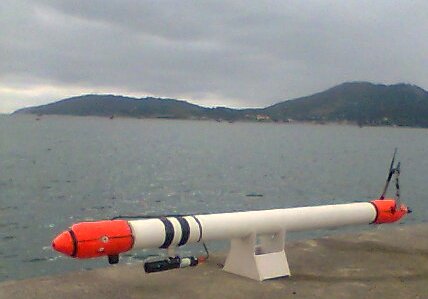
Since the beginning of 2009, the research team is actively working on the development of control techniques for teams of underwater robots. This research activity, following previous works on multi-robot systems and on single underwater robots, is mainly developed in the framework of the European Project FP7-Strep: Cooperative Cognitive Control for Autonomous Underwater Vehicles (CO3-AUVs). The research team actively participates to the project as a Unit of Interuniversity Center on Integrated Systems for Marine Environment (ISME). In particular tour group will develop cooperative control techniques for underwater robots to achieve patrolling mission keeping the ad-hoc communication network connected.
Mobile Robots [2000–]
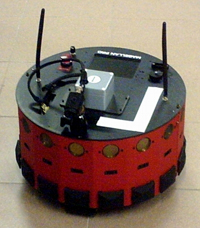
Experiments concerning the application of a real-time trajectory planning algorithm to an unicycle-like mobile robot Magellan-pro (manufactured by I-Robot) have been conducted. In the respect of the kinematic constraints (limited velocity and acceleration), the desired path has to be kept as long as possible. A fuzzy inference system handles path information in order to give to the vehicle safe behaviors such as slowing down when approaching a narrow band. Experiments concerning odometry calibration based on the least-squares technique have been conduced both with a mobile robot Magellan-pro and a mobile robot Khepera II (manufactured by K-team).
Underwater Robotics [1998–]
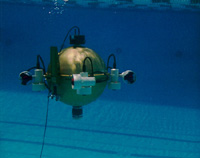
Underwater robotics is a challenging task since it implies control of a non-linear system in an unstructured environment. In case of the presence of a manipulator, the system redundancy has to be taken into account. Kinematic control, dynamic control and interaction control of underwater robotic systems have been object of our research. A software package for simulation of Autonomous Underwater Vehicles (AUV) systems have been developed. Several experiments (in the Autonomous Systems Laboratory of University of Hawaii at Manoa) of AUV dynamic control and fault tolerance control have been carried out. Moreover, a navigation system for real-time path planning and obstacle avoidance of a real AUV has been devised.
Inverse Kinematics and Redundant Manipulators [1989–]
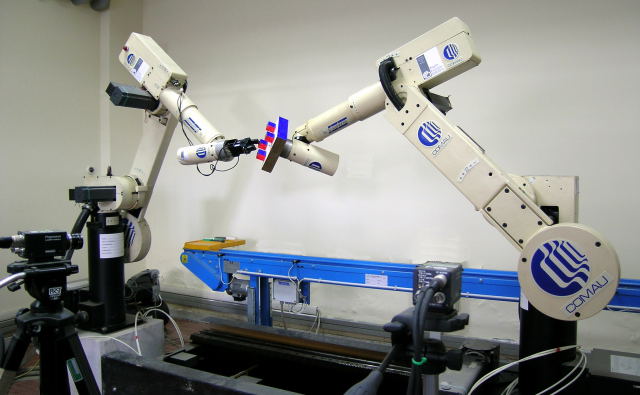
Robot control actions are naturally executed in the joint space while robot motions are specified in the task space. It is then necessary to solve an inverse kinematics problem; namely, given the end-effector trajectory, find the corresponding joint trajectories. A number of Inverse Kinematics algorithm have been studied and xperimentally validated (in the Prisma Lab) coping with redundant and non-redundant applications, kinematic joint limits, singularities, underwater applications, different orientation representations, a singularity-robust task-priority redundancy resolution for real-time kinematic control of robot manipulators has been proposed.
Identification and Control of Industrial Robots [1999–]

To improve the efficieny of the conventional controllers of industrial robots, i.e., the decentralized PD joint controllers, a number of theoretical and experimental studies (in COMAU Robotica Lab, in the Prisma Lab and in the Katholieke Universiteit Leuven, Division PMA) have been realized in order to test advanced control schemes. Identification techniques for the estimation of the robot’s dynamic and the payload parameters have been implemented for industrial robots.
Cooperative Manipulators [1988-1999]

Coordination of multiple manipulators’ systems can provide enhanced capabilities over single arm designs. Theoretical investigations and experimental tests (in the Prisma Lab) of kinematic control and operational space control have been conducted.
Other Activities []
To solve the problem of voltage waveform regulation in power system, it is necessary to take into account that power system operating conditions continuously and unpredictably change, due to variations of generations and loads, and of the network topology. An efficient solution to this problem consists in designing the voltage regulator by adopting an adaptive control-based approach in which Kalman filtering techniques, different identification procedures and pole assignment control are studied and implemented for different power systems operating conditions.
